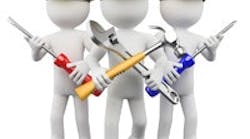COMPARATIVE MAINTENANCE COSTS
Figure 1. RCM approach led to marked reduction in maintenance costs at three plants in Jubail complex.
During the early years, plant trips were too frequent, and plant personnel only could react to process disruptions. Even with thousands of smart field devices generating ever-increasing volumes of data on the condition of critical production assets, no effective method was in use to apply that information to prevent unexpected equipment failures. In addition, personnel had no good way of knowing whether routine maintenance was being done too frequently or not often enough. Nor could they easily identify the "bad actors" — those few machines and field devices that cause the most problems. There were plenty of questions including: • How can maintenance practices be changed to produce better results? • What equipment fails most often and what's behind that failure frequency?• Which assets represent the greatest risk to availability?• Are maintenance dollars being spent properly to achieve high reliability?
GETTING ANSWERSSipchem turned to
Emerson Process Management's Asset Optimization Services group to help improve plant performance. In the last four years, this group has performed reliability-centered maintenance (RCM) on all existing production units at Jubail, covering approximately 20,000 assets.This work, which began in the Acetyls Complex, involved validating information that already had been entered into an SAP computerized maintenance management system (CMMS) and including many more assets, some of which were purposely omitted from SAP when the plant was built. Also, it addressed a serious deficiency in the way assets were described — using general terminology rather than tag numbers. That created a real problem for the maintenance organization because there was no way of tracking many of the maintenance procedures, and no idea where maintenance dollars were being spent.In the end, some 5,000 assets listed in the Integraph Intools software used in designing and starting up the complex were properly identified and transitioned into the CMMS. Asset ranking criteria were developed initially as a part of the RCM process. Every asset was ranked according to its importance in maintaining product throughput, quality, safety and environmental compliance. Among the highest-ranking assets were the reactor area uninterruptible-power-supply distribution panel, the blowdown-drum pump motor, crude pump motors, and a flash column sidedraw pump.Those high-priority assets now receive immediate maintenance when necessary, while those of less importance get attention commensurate with their criticality ranking. With all these assets now in the CMMS, we can provide more-effective maintenance for the entire Acetyls Complex. This is the essence of RCM. At the same time, we now keep and continually update a very complete record of all maintenance activities.
IMPROVING DIAGNOSTICSMost field instrumentation at Sipchem incorporate predictive intelligence; our new maintenance program takes advantage of the diagnostic information derived from those smart field devices. This has involved implementing Emerson's AMS Suite predictive maintenance software, which was initially installed on site but not fully utilized. The software provides easy access to the field-generated data via the DeltaV digital automation system. In this way, maintenance and control-room personnel can obtain real-time performance information from any specific smart transmitter or control valve at any time. The software continually monitors the online devices and raises a status alert when the performance of any device, or the equipment to which it is mounted, falls below a prescribed norm. Maintenance and reliability managers can evaluate the situation to decide whether to address it immediately or wait until the next scheduled shutdown. Knowledge is the key for the predictive maintenance strategy under which our plants operate today. Our managers now can make informed and timely maintenance decisions, improving reliability and increasing plant availability. Predictive maintenance has proven to be less expensive over the long run than preventive maintenance and far less costly than reactive maintenance, where personnel rush to remedy unexpected equipment failures with no long-term strategy. Figure 1 shows that comparative maintenance costs for three different plants at the complex significantly decreased from 2010 to 2011.
ASSESSING ASSET PERFORMANCETo give management a better understanding (plus documentation) of what's happening in production units, Sipchem chose to implement Emerson's AMS Suite: Asset Performance Management (APM), built on Meridium's APM software. This application can process the huge volumes of field-based information being collected and automates the flow of data from the field to our business network.AMS Suite APM integrates predictive intelligence with asset reliability information and delivers accurate data to the CMMS. This enables creation of precise maintenance orders based on the criticality ranking of the assets, giving us a powerful tool to improve the performance of the equipment that is most important to plant reliability.The software can be customized for each user. It features a device dashboard that provides an immediate view of asset performance, availability and maintenance in each plant. It also displays historical charts that show monthly results for overall equipment effectiveness, availability and maintenance costs. Designed for easy navigation, this system allows users to obtain greater detail on any of these factors. Without a doubt, asset ranking helps us shine the reliability spotlight on assets that need our attention from both the operational and maintenance perspectives. Failures are tracked, so the bad actors that account for so much maintenance time and expense can be spotted and replaced. Some of the frequently failing assets we were able to pinpoint included a carbon dioxide compressor seal, catalyst recycle pumps, high-pressure methanol feed pumps and high-pressure reactor feed pumps.




